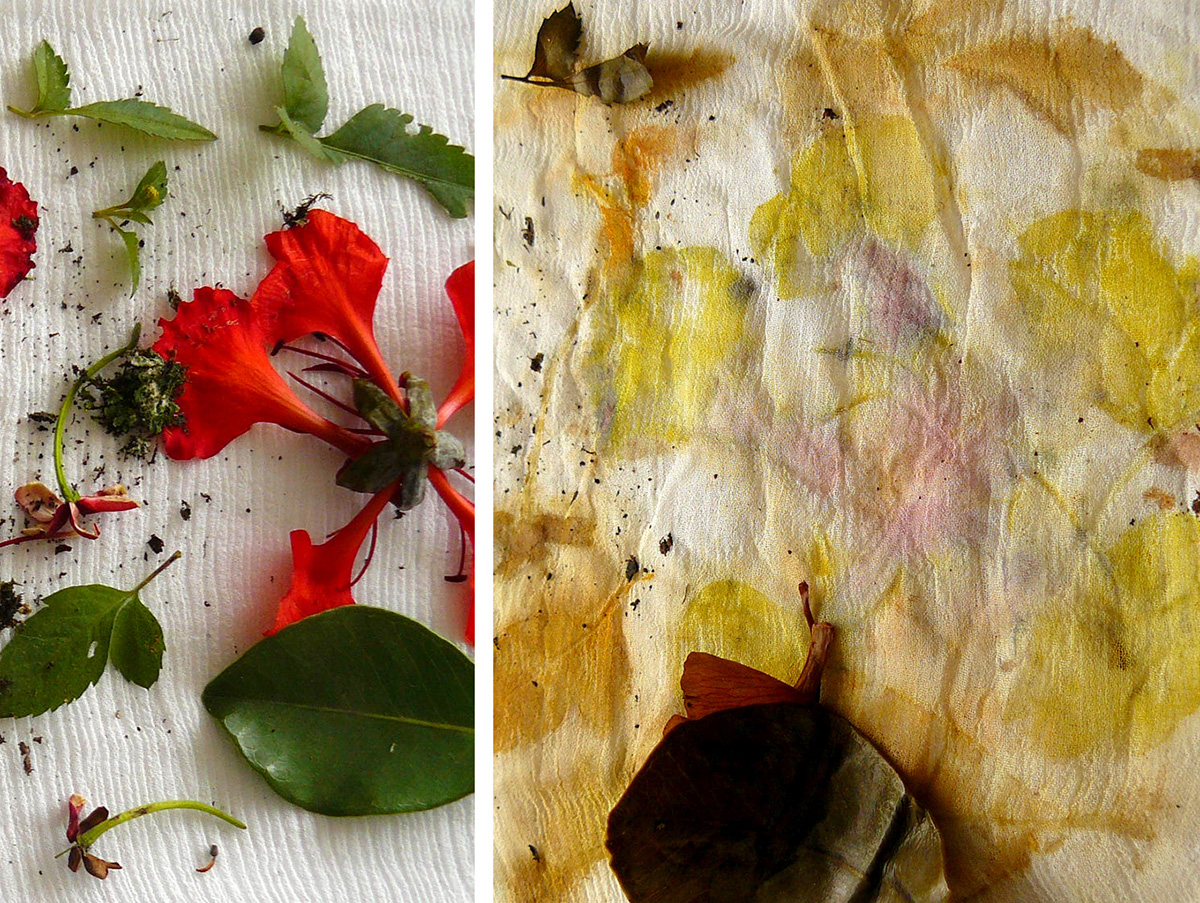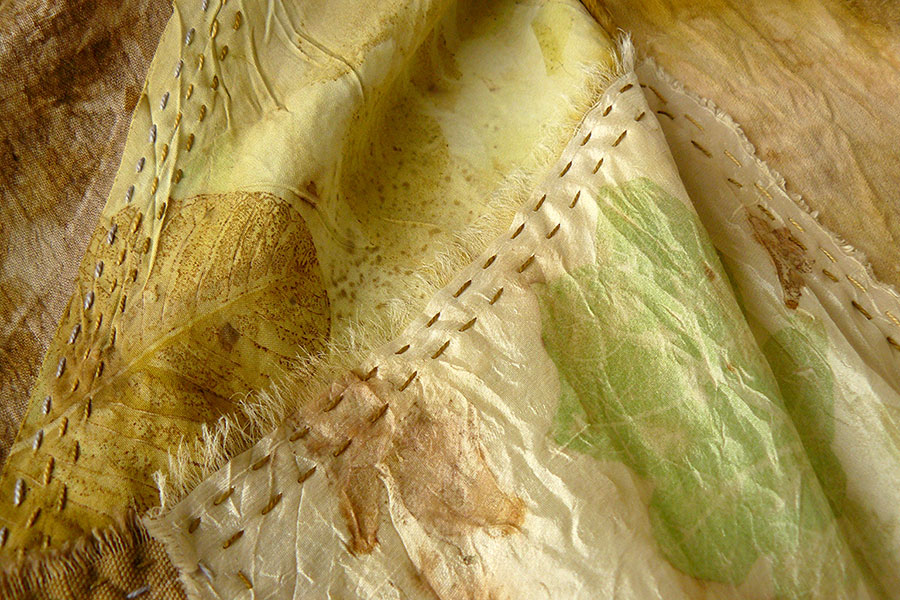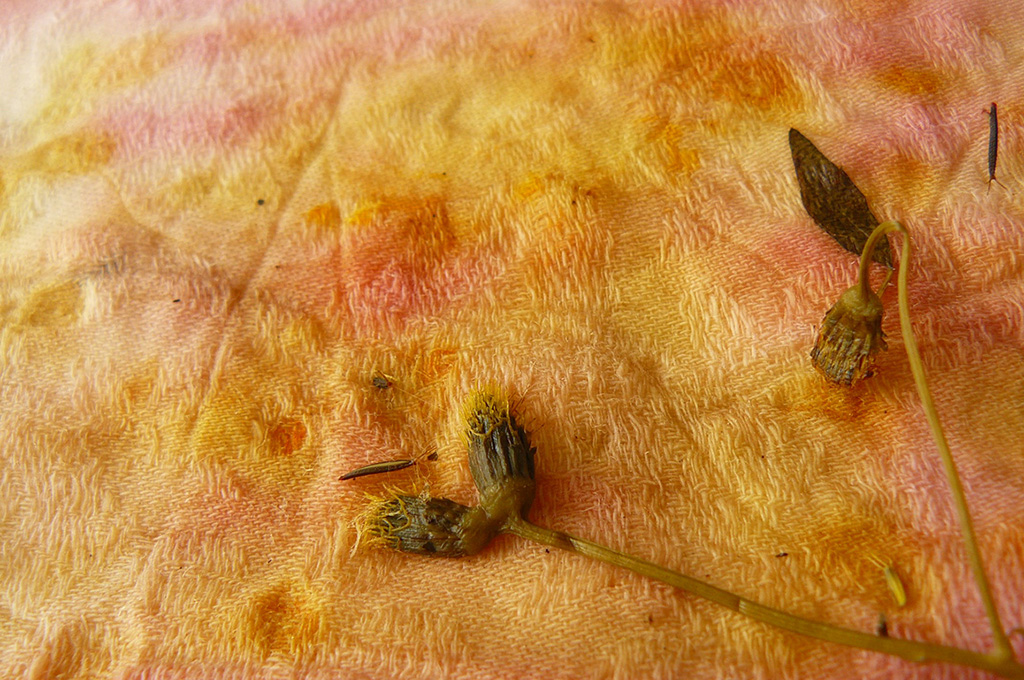
I wake up early. The blue of the sky above the rush city shines promising a beautiful day. I’m already anxious to get out: today is botanical contact printing day. The first task, if we might call it a task because for me it is pleasure, is to pick up the material that will be our matrix for the print: plants! I don’t need to go so far – which is good use in this quarantine time – a quick stroll around my block, in a residential neighbourhood of Sao Paulo, is enough to offer all that I need. I pick fallen leaves on the ground – some of them are dry and some just have fallen – and some seeds have been tossed by trees. I glean flowers that already have fallen and some flowers which are almost wilting at the tree. I catch some resilient herbs that grow on curb cracks, they are abundant, and some leaves that are abundantly filled busts and trees when I recognized this is not prejudicial for the plant. And I come back home very happy. I know that all my impressions about this fall day will be registered on scraps of fabric that have already soaked in a mordant bath since last night. Plants will be changed onto alive nature prints.
Botanical contact printing bundle made with pink knotweed
Pink knotweed growing on wall
Guava tree on São Paulo street
Botanical contact printing with guava leaves on silk fabric
Beyond being an explanation about technique details of botanical contact printing method, this text is an effort to share one glance, at the same time simple, deep and joyful, about plants that surround us, which became invisible to us in our daily life rush, although they are in everywhere, coexisting with all living being, including us.
How it all started

When I have began interesting in natural dyeing – I had researched tirelessly for tutorials on the internet – soon I have discovered the eco-print or botanical contact printing. The picture above shows one of my first experiments. Under a scrap of fabric previously dyeing, I distributed slices of tropical almond leaves, eucalyptus leaves, dry hibiscus flower, guava leaves, one red shrimp flower plant and bee pollen. In a way, the result was disappointed: “Why does not the right outline of the leaves appear?”. On the other hand, I was so fascinated by colours that I acquire from so few plants that I dived deep into my researches.
At this moment, I met India Flint, an Australian textile art. Her work is so sensitive and it touches me deeply. The invention of eco-print is attributed to her. In her book “Eco Colour: botanical dyes for beautiful textiles”, she told us what was your inspiration to create this technique:
When I was a very small child, I had the great good fortune to be cared for my maternal grandmother while my mother pursued studies in art. Little did I realize how influential her guidance would prove and that I would eventually make living using simple techniques she taught me all those years ago. […] My mother too, played a fundamental role in nurturing what would become my passion, as in addition to instructing me in the art of botanical observation and illustration, it was she who took charge of dyeing the eggs for the Easter celebrations every year. In the Latvian tradition, fresh hen eggs are wrapped in layers of plant material, beginning with tiny green strawberry leaves and other pretty herbs from the garden, finishing with a good layer of dark brown onion skins. The bundled eggs are placed in a saucepan with water, brought to boil, simmered for ten minutes and allowed to cool. Unwrapping each egg is always a delight as delicate patterns are revealed, each one unique. Experimenting with the egg-dyeing traditions using eucalyptus leaves on cloth led me to the discovery of the eco-print in 1999.”
Reproductions of the book “Eco Colour: botanical dyes for beautiful textiles” de India Flint
India Flint knows how multiple the beautiful legacy that was gifted to her by her grandmother and her mother, when she gifts to all of us. We must be deeply grateful, enjoy it, learn well and share this knowledge – this is the first intention of my work. The most important thing is to be able to spread the seeds of botanical contact printing. Or, will it better say, to spread the wisdom that the plants offer to us through botanical contact printing?
The alchemy of colours’ plants
The botanical contact printing method is very simple. We need basically plants, fabric, water, heath and time. In a very similar process with the traditional natural dyeing, botanical contact printing is like cooking with colours: the heath and the time will make the magic.
Basically, the process is:
- We spread the plants on a scrap of fabric, which is pre-mordanting;
- We roll the fabric firmly with the plants inside. For this, we can use a cylinder support like the bamboo showed in the pictures above. The plants must are in direct contact with the fabric.
- We tie tightly with string to make a bundle.
- We place the bundle in a pot with water and, if we prefer, with dye plant leaves too. In the left picture above, you see two bundles in a pot with water, guava and almond tree leaves.
- We heath the pot to simmering point, then simmer for 2 hours. Watch out to the water doesn´t dry.
- We remove the bundle from the pot, carefully and with tongs, allow it to cool and unwrap it.
The result is amazing! What you see on fabric is the direct transfer of plant pigments, that printing impressions, colours, and unique forms on fibre.
Technically, what is happening is a chemical reaction between dye plant substances and the mordants, that will fix the colours into the fabric fibres through heath. In addition to the pigments that will be colouring the fabric, to will acquire the perfect flower and leaf outlines, the plant must have tannin in its chemical composition. Tannins are one of the signs that the plant is a dye plant. Tannins are astringent substances that participated in the plant immune system, which are also widely used like mordant all around the world.
Here, we enter another fundamental field of botanical contact printing: the mordants. Like every natural dyeing process, mordants are substances that used to fix the colours. In the botanical contact printing process, the fabric is pre-mordanting, which means it was put in the mordant bath before dye. Usually, I used 3 kinds of mordants for my printings, iron, ash´s water and alum. All of them change the colours on the fabric as we can see in the picture below:

If the plant contains tannin, the chemical reaction is stronger. Look to these examples below. In the first one, I used iron to mordanting the cotton fabric. These tiny black spots that forming the eucalyptus leaf drawing is the tannin that was reacted with the iron. In the second silk fabric I used alum as mordant. The colour became lighter and the eucalyptus leaf changes its hue.
Botanical contact printing with eucalyptus leaves using iron as mordent on cotton fabric
Botanical contact printing with eucalyptus leaf using alum as mordent on silk fabric
Another key factor about botanical contact printing is the fabric. The final result will be different depending on some fabric aspects such as type of fibre – if animal fibres or plant fibre, density of fabric weave – if open or tight weave, and fabric thickness.
Paper can also be used in the botanical contact print process. It is important to say that the best material we can use is the natural one. Paper comes from cellulose, which is originated from wood. That´s why fabrics should be made from natural fibres like cotton, rami, linen, silk and wool. Synthetic fabric and material are not a good choice for natural dyeing.
Botanical contact printing is a live process and completely artisanal. At the same time that the process is very simple each detail of the work, each artisan gesture influences the final result. In this text, I have traced a sketch, which I only highlight fundamental points for the botanical contact printing alchemy takes place. There are so many possibilities during the process, if I will detail them this text will become a book. With time and experience, we can discover more and more details and perhaps we can evolve a little bit of control over the process. If it is your first time, don´t rush. Like any alchemical transformation, time and patience are our best allies. Especially when we begin a relationship with the plant world. This fascinating and sometimes mysterious world.
Memories of a garden

In the botanical contact printing is almost impossible to repeat the same result twice. Each print fabric is unique. Each fabric scrap told us a story. Stories of rain, wind, sun, hands, happiness and grieves. Memories permanently printed through colours and forms. Writing this text, I have wondered: what is so special to me in this craft? The answer was given to me by Brazilian poet Manoel de Barros.
I always remember the garden of my childhood house. It was a quite large garden for a house in Sao Paulo. For me, who was a quiet and shy girl, it was my world. Every time I stayed there, playing. I loved to climb trees, especially a bay tree, and to pretend to cook with plants. I observed every detail. It was a garden that grows half by itself, half by my mother’s hands. She loved to plant. She planted a mango tree, vine and avocado tree. Besides what already is there: tangerine tree, persimmon tree and fig tree.
When I read this excerpt of the book “Invented memories: the childhood”, by Manoel de Barros, I got emotional and immediately I remembered my garden:
I have a rude wilderness inside my eyes. Because of this wilderness, I haven’t been a mischievous boy. Now I miss what I haven´t been. I think that what now I do is what I haven´t could do in childhood. I do another kind of mischief. When I was a child I have should jump the neighbour´s wall to catch guava. But there isn´t a neighbour. Instead of mischief, I have done solitude. I have played to pretend that a rock was a lizard. That a can was a ship. That a corncob was a little living being similar to a grasshopper puppy.
I have grown playing on the ground, between ants. From a free childhood and without comparison. I have had more communion with things than comparison. Because if we talk from to be a child, we do communion: an orval with its spider, an evening with its egrets, a bird with his tree. So I bring from my childhood roots that communion and oblique view of things. I know to say without shame that the darkness lights me. This is a paradox that helps the poetry and that I say without shame. I have this oblique view that comes from I have being a child in some lost place where there were nature transfusion and communion with it. It was the boy and the little animals. It was the boy and the sun. It was the boy and the river. It was the boy and the trees.” (English version made by me)
That´s it! For me, botanical contact printing and natural dyeing are the rescue of this communion with nature. It is the encounter with what we have already were when child. Only a poet could express so beautifully this feeling that I bring with me. Perfectly and poetically described!
Chilhood leaves: begonia aconitifolia
Botanical contact printing with begonia leaves on cotton gauze
In one of my wanderings nearby Rio Verde´s course, at Vila Madalena neighbourhood, I have found some of leaves that was caught my attention in my childhood house garden when I was a child. I got happy like a child. I couldn’t resist picking some leaves to test. These are the spotted cropped beautiful leaves that you can see in the first picture above. I have discovered that this plant is a kind of begonia, the begonia aconitifolia, botanists correct me if I wrong. The result of the test, which you can see in the next picture above, was amazing.
As was common in our girls’ or boys’ life, the botanical contact printing awake a sense of curiosity, play and purity. I’m cheering for you too can experience this process that is so special. Because this allows us to rescue a naive simplicity from those times we can have fun with so little. For me, this is botanical contact printing. With a little difference: before my garden was one of my childhood’s house, nowadays my garden spreads to the São Paulo streets. How? Well, just look to the ground!
Fig tree leaves on the square floor in São Paulo
Gleaning plants that grows on sidewalk streets in São Paulo
Continues in the next post

I am preparing the English version of the next post about botanical contact printing Impressões Botânicas – Plantas brasileiras on my blog.
To know the scarfs that I made with botanical contact printing, click on the links below:
Credit
Photography and text revision by Gil Gosch, except the reproductions of the book and sites.
Bibliografy
BARROS, Manoel de. Memórias inventadas: a infância. São Paulo: Planeta, 2003.
FLINT, India. Eco colour: botanical dyes for beautiful textiles. Fort Collins: Interweave, 2008. 238 p.
MAUREAU, Xavier. A tecelagem manual no Triângulo Mineiro: uma abordagem tecnológica. Sphan / Fundação Nacional Pró-memória, 1984. 124 p.

[…] the botanical contact printing which enchanted me. I wrote a text only on this subject in the post Botanical contact printing – A delightful natural dyeing technique. I never tired of dyeing samples and more samples of fabric scraps, which were hand stitching to […]